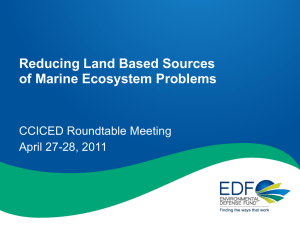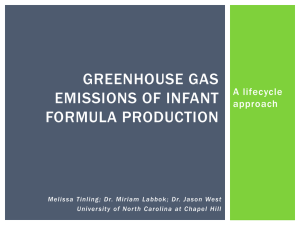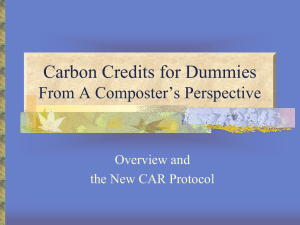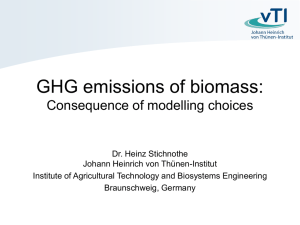Carbon Adjustment Emissions True Up Examples - 09-03
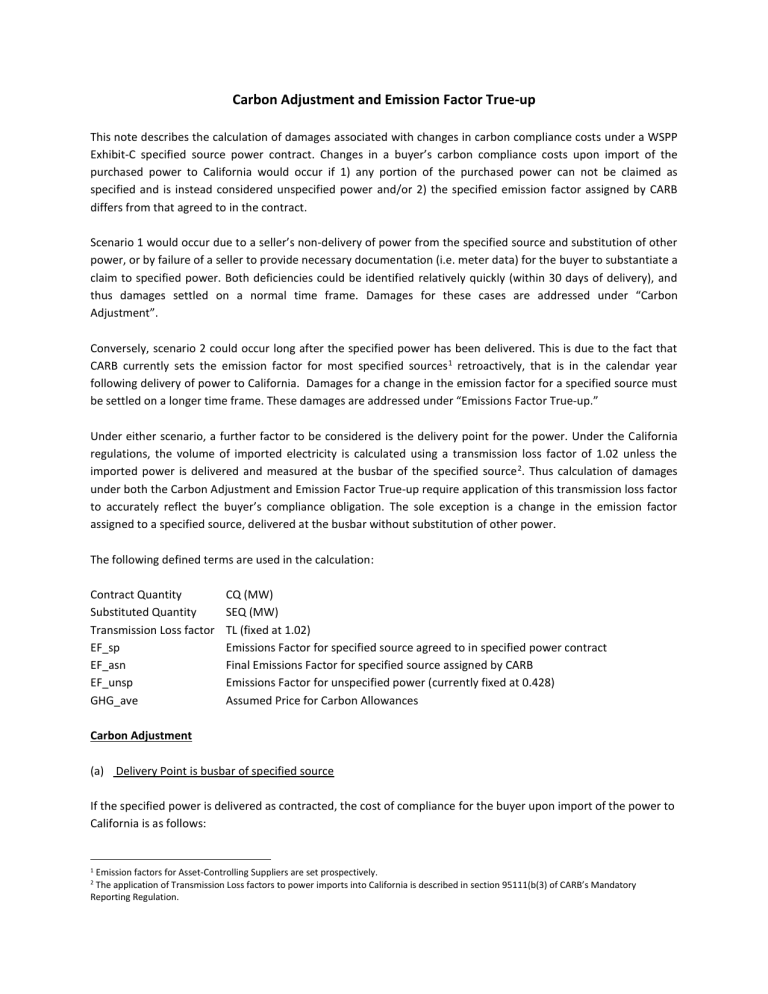
Carbon Adjustment and Emission Factor True-up
This note describes the calculation of damages associated with changes in carbon compliance costs under a WSPP
Exhibit-C specified source power contract. Changes in a buyer’s carbon compliance costs upon import of the purchased power to California would occur if 1) any portion of the purchased power can not be claimed as specified and is instead considered unspecified power and/or 2) the specified emission factor assigned by CARB differs from that agreed to in the contract.
Scenario 1 would occur due to a seller’s non-delivery of power from the specified source and substitution of other power, or by failure of a seller to provide necessary documentation (i.e. meter data) for the buyer to substantiate a claim to specified power. Both deficiencies could be identified relatively quickly (within 30 days of delivery), and thus damages settled on a normal time frame. Damages for these cases are addressed under “Carbon
Adjustment”.
Conversely, scenario 2 could occur long after the specified power has been delivered. This is due to the fact that
CARB currently sets the emission factor for most specified sources 1 retroactively, that is in the calendar year following delivery of power to California. Damages for a change in the emission factor for a specified source must be settled on a longer time frame. These damages are addressed under “Emissions Factor True-up.”
Under either scenario, a further factor to be considered is the delivery point for the power. Under the California regulations, the volume of imported electricity is calculated using a transmission loss factor of 1.02 unless the imported power is delivered and measured at the busbar of the specified source 2 . Thus calculation of damages under both the Carbon Adjustment and Emission Factor True-up require application of this transmission loss factor to accurately reflect the buyer’s compliance obligation. The sole exception is a change in the emission factor assigned to a specified source, delivered at the busbar without substitution of other power.
The following defined terms are used in the calculation:
Contract Quantity
Substituted Quantity
CQ (MW)
SEQ (MW)
Transmission Loss factor TL (fixed at 1.02)
EF_sp Emissions Factor for specified source agreed to in specified power contract
EF_asn
EF_unsp
Final Emissions Factor for specified source assigned by CARB
Emissions Factor for unspecified power (currently fixed at 0.428)
Assumed Price for Carbon Allowances GHG_ave
Carbon Adjustment
(a) Delivery Point is busbar of specified source
If the specified power is delivered as contracted, the cost of compliance for the buyer upon import of the power to
California is as follows:
1 Emission factors for Asset-Controlling Suppliers are set prospectively.
2 The application of Transmission Loss factors to power imports into California is described in section 95111(b(3) of CARB’s Mandatory
Reporting Regulation.
CQ × EF_sp × GHG_ave (1)
In case of non-delivery of specified source power and substitution of a portion (SEQ) of the contracted amount
(CQ) by unspecified power, the compliance cost is as follows:
((CQ – SEQ) × EF_sp × GHG_ave) + (SEQ × TL × EF_unsp × GHG_ave)
The increase in compliance cost is (2) – (1) and equals:
(2)
Carbon Adjustment (busbar case) = SEQ × (TL × EF_unsp-EF_sp) × GHG_avg
(b) Delivery point is not the busbar of specified source
Next consider the case where the purchase of specified power does not occur at busbar. In this case, the compliance cost when specified power is delivered as contracted is as follows:
CQ × TL × EF_sp × GHG_ave
(3)
(4)
In case of non-delivery of specifies source power and substitution of a portion (SEQ) of the contracted amount
(CQ) by unspecified power, the compliance cost is as follows:
(CQ – SEQ) × TL × EF_sp × GHG_ave + SEQ × TL × EF_unsp × GHG_ave (5)
The increase in compliance cost is (5) – (4) and equals:
Carbon Adjustment (non busbar case) = SEQ × TL × (EF_unsp-EF_sp) × GHG_avg (6)
Equations (3) and (6) describe the carbon adjustment for non-delivery of specified power when contracted at busbar and non busbar locations respectively.
Emissions Factor True-up
(a) Delivery point is busbar of specified source
To keep things simple, consider the case where there is no substitution and the entire contracted quantity is delivered from the specified source. The cost of compliance is described by (1). If the final emissions factor assigned by CARB is EF_asn, the actual compliance cost changes to:
CQ × EF_asn × GHG_ave
The change in compliance cost from what was assumed at time of contracting is (7) – (1) and equals
(7)
CQ × (EF_asn – EF_sp) × GHG_ave (8)
More generally, this should only apply to the quantity of specified power that has not been substituted by unspecified power. The change in compliance cost for the more general case where a portion (SEQ) is substituted by unspecified power would be:
(9) Emissions Factor True-up (busbar case) = (CQ – SEQ) × (EF_asn – EF_sp) × GHG_ave
(b) Delivery point is not the busbar of specified source
Cost of compliance at agreed upon emissions factor and without substitution is described by (4). If the final emissions factor changes to EF_asn, the compliance cost changes to:
CQ × TL × EF_asn × GHG_ave (10)
The change in compliance cost from what was assumed at the time of contracting is (10) – (4) and equals:
CQ × TL × (EF_asn – EF_sp) × GHG_ave (11)
More generally, this should only apply to the quantity of specified power that has not been substituted by unspecified power. The change in compliance cost for the more general case where a portion of (SEQ) is substituted by unspecified power would be:
Emissions Factor True-up (non busbar case) = (CQ –SEQ) × TL × (EF_asn – EF_sp) × GHG_ave (12)
Equations (9) and (12) describe the Emissions true-up for the busbar and non-busbar cases for a specified power contract. Depending on preferences of contracting parties, this could be restricted to apply only when there is an increase in the agreed upon emissions factor (i.e., EF_asn > EF_sp). In this case, the Emissions true-up for the two cases can be written as:
Emissions Factor True-up (busbar case) = max {0, ((CQ – SEQ) × (EF_asn – EF_sp) × GHG_ave)} (13)
Emissions Factor True-up (non busbar case) = max {0, ((CQ –SEQ) × TL × (EF_asn – EF_sp) × GHG_ave)} (14)
Numerical example described in attached spreadsheet.
Contract Quantity CQ (MW)
Substituted Quantity SEQ (MW)
Transmission Loss factor TL
EF_sp
EF_asn
EF_unsp
GHG_avg ($/ton)
100
50
1.02
0.15
0.2
0.428
15
Example 1 Busbar purchase of 100 MW specified power
If entire 100 MW is delivered, the compliance cost at original EF_sp is as follows:
CQ ×EF_sp × GHG_avg = $225
If 50 MW is substituted by unspecified power and final EF is updated to EF_asn > EF_sp, compliance cost is:
((CQ-SEQ) × EF_asn+SEQ × TL × EF_unsp) × GHG_avg = $477.42
The increase in compliance cost is 477.42 – 225 = $252.42
Carbon Adjustment = SEQ × (TL × EF_unsp-EF_sp) × GHG_avg = $214.92
Emissions Factor true up = (CQ-SEQ) × (EF_asn-EF_sp) × GHG_avg = $37.5
Total Damages = 214.92 + 37.5 = $252.42
Example 2 Non busbar purchase of 100 MW specified power
If entire 100 MW is delivered, the compliance cost at original EF_sp is as follows:
CQ × EF_sp × TL× GHG_avg = $229.5
If 50 MW is substituted by unspecified power and final EF is updated to EF_asn > EF_sp, compliance cost is:
((CQ-SEQ) × TL × EF_asn+SEQ×TL×EF_unsp) × GHG_avg = $480.42
The increase in compliance cost is 480.42 – 229.5 = $250.92
Carbon Adjustment = SEQ × TL × (EF_unsp-EF_sp) × GHG_avg = $212.67
Emissions Factor true up = (CQ-SEQ) ×TL×( EF_asn-EF_sp) × GHG_avg = $38.25
Total Damages = 212.67 + 38.25= $250.92


